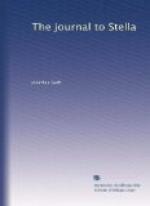During a visit to England in the winter of 1703-4 we find Swift in correspondence with the Rev. William Tisdall, a Dublin incumbent whom he had formerly known at Belfast. Tisdall was on friendly terms with Stella and Mrs. Dingley, and Swift sent messages to them through him. “Pray put them upon reading,” he wrote, “and be always teaching something to Mrs. Johnson, because she is good at comprehending, remembering and retaining.” But the correspondence soon took a different turn. Tisdall paid his addresses to Stella, and charged Swift with opposing his suit. Tisdall’s letters are missing, but Swift’s reply of April 20, 1704, puts things sufficiently clearly. “My conjecture is,” he says, “that you think I obstructed your inclinations to please my own, and that my intentions were the same with yours. In answer to all which I will, upon my conscience and honour, tell you the naked truth. First, I think I have said to you before that, if my fortunes and humour served me to think of that state, I should certainly, among all persons upon earth, make your choice; because I never saw that person whose conversation I entirely valued but hers; this was the utmost I ever gave way to. And secondly, I must assure you sincerely that this regard of mine never once entered into my head to be an impediment to you.” He had thought Tisdall not rich enough to marry; “but the objection of your fortune being removed, I declare I have no other; nor shall any consideration of my own misfortune, in losing so good a friend and companion as her, prevail on me, against her interest and settlement in the world, since it is held so necessary and convenient a thing for ladies to marry, and that time takes off from




